Inca Civilization › Maya Religion » Ancient origins
Articles and Definitions › Contents
- Inca Civilization › Ancient History
- Maya Religion: The Light That Came From Beside The Sea › Antique Origins
Ancient civilizations › Historical and archaeological sites
Inca Civilization › Ancient History
Definition and Origins
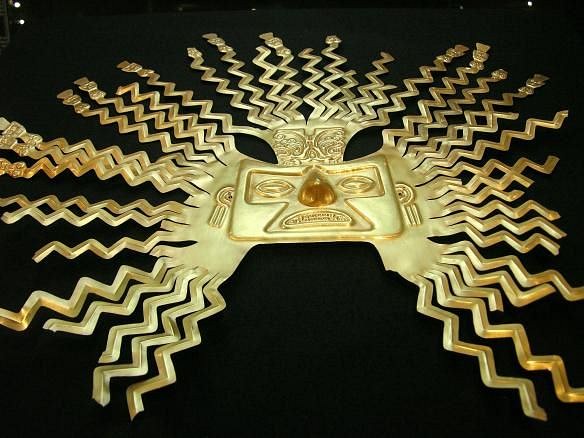
The Inca civilization flourished in ancient Peru between c. 1400 and 1533 CE, and their empire eventually extended across western South America from Quito in the north to Santiago in the south, making it the largest empire ever seen in the Americas and the largest in the world at that time. Undaunted by the often harsh Andean environment, the Incas conquered people and exploited landscapes in such diverse settings as plains, mountains, deserts, and tropical jungle. Famed for their unique art and architecture, they constructed finely-built and imposing buildings wherever they conquered, and their spectacular adaptation of natural landscapes with terracing, highways, and mountaintop settlements continues to impress modern visitors at such world famous sites as Machu Picchu.
HISTORICAL OVERVIEW
As with other ancient Americas cultures, the historical origins of the Incas are difficult to disentangle from the founding myths they themselves created. According to legend, in the beginning, the creator god Viracocha came out of the Pacific Ocean, and when he arrived at Lake Titicaca, he created the sun and all ethnic groups. These first people were buried by the god and only later did they emerge from springs and rocks (sacred pacarinas ) back into the world. The Incas, specifically, were brought into existence at Tiwanaku (Tiahuanaco) from the sun god Inti, hence, they regarded themselves as the chosen few, the 'Children of the Sun', and the Inca ruler was Inti's representative and embodiment on earth. In another version of the creation myth, the first Incas came from a sacred cave known as Tampu T'oqo or 'The House of Windows', which was located at Pacariqtambo, the 'Inn of Dawn', south of Cuzco. The first pair of humans were Manco Capac (or Manqo Qhapaq) and his sister (also his wife) Mama Oqllu (or Ocllo). Three more brother-sister siblings were born, and the group set off together to found their civilization. Defeating the Chanca people with the help of stone warriors ( pururaucas ), the first Incas finally settled in the Valley of Cuzco and Manco Capac, throwing a golden rod into the ground, established what would become the Inca capital, Cuzco.
40,000 INCAS GOVERNED A TERRITORY WITH 10 MILLION SUBJECTS SPEAKING OVER 30 DIFFERENT LANGUAGES.
More concrete archaeological evidence has revealed that the first settlements in the Cuzco Valley actually date to 4500 BCE when hunter-gather communities occupied the area. However, Cuzco only became a significant centre sometime at the beginning of the Late Intermediate Period (1000-1400 CE). A process of regional unification began from the late 14th century CE, and from the early 15th century CE, with the arrival of the first great Inca leader Pachacuti Inca Yupanqui ('Reverser of the World') and the defeat of the Chanca in 1438 CE, the Incas began to expand in search of plunder and production resources, first to the south and then in all directions. They eventually built an empire which stretched across the Andes, conquering such peoples as the Lupaka, Colla, Chimor, and Wanka civilizations along the way. Once established, a nationwide system of tax and administration was instigated which consolidated the power of Cuzco.
The rise of the Inca Empire was spectacularly quick. First, all speakers of the Inca language Quechua (or Runasimi ) were given privileged status, and this noble class then dominated all the important roles within the empire. Thupa Inca Yupanqui (also known as Topa Inca), Pachacuti 's successor from 1471 CE, is credited with having expanded the empire by a massive 4,000 km (2,500 miles). The Incas themselves called their empire Tawantinsuyo (or Tahuantinsuyu ) meaning 'Land of the Four Quarters' or 'The Four Parts Together'. Cuzco was considered the navel of the world, and radiating out were highways and sacred sighting lines ( ceques ) to each quarter: Chinchaysuyu (north), Antisuyu (east), Collasuyu (south), and Cuntisuyu(west). Spreading across ancient Ecuador, Peru, northern Chile, Bolivia, upland Argentina, and southern Colombia and stretching 5,500 km (3,400 miles) north to south, 40,000 Incas governed a huge territory with some 10 million subjects speaking over 30 different languages.
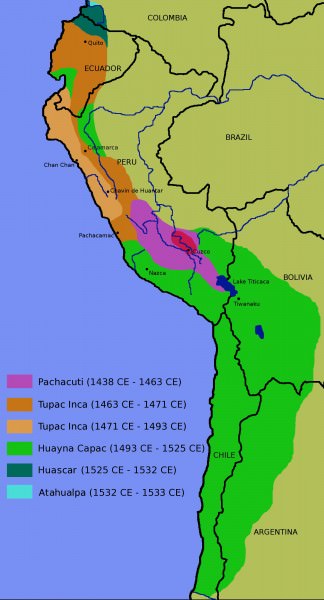
Map of the inca Empire
GOVERNMENT & ADMINISTRATION
The Incas kept lists of their kings ( Sapa Inca ) so that we know of such names as Pachacuti Inca Yupanqui (reign c. 1438-63 CE), Thupa Inca Yupanqui (reign c. 1471-93 CE), and Wayna Qhapaq (the last pre-Hispanic ruler, reign c. 1493-1525 CE). It is possible that two kings ruled at the same time and that queens may have had some significant powers, but the Spanish records are not clear on both points. The Sapa Inca was an absolute ruler, and he lived a life of great opulence. Drinking from gold and silver cups, wearing silver shoes, and living in a palace furnished with the finest textiles, he was pampered to the extreme. He was even looked after following his death, as the Inca mummified their rulers. Stored in the Coricancha templein Cuzco, the mummies ( mallquis ) were, in elaborate ceremonies, regularly brought outside wearing their finest regalia, given offerings of food and drink, and 'consulted' for their opinion on pressing state affairs.
Inca rule was, much like their architecture, based on compartmentalised and interlocking units. At the top was the ruler and ten kindred groups of nobles called panaqa. Next in line came ten more kindred groups, more distantly related to the king and then, a third group of nobles not of Inca blood but made Incas as a privilege. At the bottom of the state apparatus were locally recruited administrators who oversaw settlements and the smallest Andean population unit the ayllu, which was a collection of households, typically of related families who worked an area of land, lived together and provided mutual support in times of need. Each ayllu was governed by a small number of nobles or kurakas, a role which could include women.
Local administrators reported to over 80 regional-level administrators who, in turn, reported to a governor responsible for each quarter of the empire. The four governors reported to the supreme Inca ruler in Cuzco. To ensure loyalty, the heirs of local rulers were also kept as well-kept prisoners at the Inca capital. The most important political, religious, and military roles within the empire were, then, kept in the hands of the Inca elite, called by the Spanish the orejones or 'big ears' because they wore large earspools to indicate their status. To better ensure the control of this elite over their subjects, garrisons dotted the empire, and entirely new administrative centres were built, notably at Tambo Colorado, Huánuco Pampa and Hatun Xauxa.
For tax purposes censuses were taken and populations divided up into groups based on multiples of ten (Inca mathematics was almost identical to the system we use today). As there was no currency in the Inca world, taxes were paid in kind - usually foodstuffs, precious metals, textiles, exotic feathers, dyes, and spondylus shell - but also in labourers who could be shifted about the empire to be used where they were most needed, known as mit'a service. Agricultural land and herds were divided into three parts: production for the state religion and the gods, for the Inca ruler, and for the farmers own use. Local communities were also expected to help build and maintain such imperial projects as the road system which stretched across the empire. To keep track of all these statistics, the Inca used the quipu, a sophisticated assembly of knots and strings which was also highly transportable and could record decimals up to 10,000.
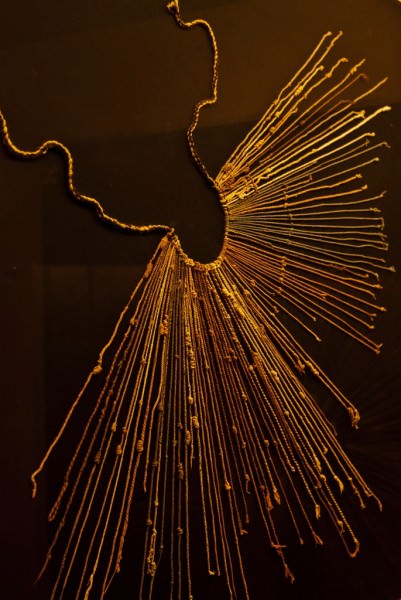
Khipu
MOST SPLENDID WERE THE TEMPLES BUILT IN HONOUR OF INTI AND MAMA KILYA - THE FORMER WAS LINED WITH 700 2KG SHEETS OF BEATEN GOLD.
CUZCO
The Inca capital of Cuzco (from qosqo, meaning 'dried-up lake bed' or perhaps derived from cozco, a particular stone marker in the city ) was the religious and administrative centre of the empire and had a population of up to 150,000 at its peak.Dominated by the sacred gold-covered and emerald-studded Coricancha complex (or Temple of the Sun ), its greatest buildings were credited to Pachacuti. Most splendid were the temples built in honour of Inti and Mama Kilya - the former was lined with 700 2kg sheets of beaten gold, the latter with silver. The whole capital was laid out in the form of a puma (although some scholars dispute this and take the description metaphorically) with the imperial metropolis of Pumachupan forming the tail and the temple complex of Sacsayhuaman (or Saqsawaman) forming the head. Incorporating vast plazas, parklands, shrines, fountains, and canals, the splendour of Inca Cuzco now, unfortunately, survives only in the eye-witness accounts of the first Europeans who marvelled at its architecture and riches.
INCA RELIGION
The Inca had great reverence for two earlier civilizations who had occupied much the same territory - the Wari and Tiwanaku.As we have seen, the sites of Tiwanaku and Lake Titicaca played an important part in Inca creation myths and so were especially revered. Inca rulers made regular pilgrimages to Tiwanaku and the islands of the lake, where two shrines were built to Inti the Sun god and supreme Inca deity, and the moon goddess Mama Kilya. Also in the Coricancha complex at Cuzco, these deities were represented by large precious metal artworks which were attended and worshipped by priests and priestesses led by the second most important person after the king: the High Priest of the Sun ( Willaq Umu ). Thus, the religion of the Inca was preoccupied with controlling the natural world and avoiding such disasters as earthquake, floods, and drought, which inevitably brought about the natural cycle of change, the turning over of time involving death and renewal which the Inca called pachakuti.
Sacred sites were also established, often taking advantage of prominent natural features such as mountain tops, caves, and springs. These huacas could be used to take astronomical observations at specific times of the year. Religious ceremonies took place according to the astronomical calendar, especially the movements of the sun, moon, and Milky Way ( Mayu ).Processions and ceremonies could also be connected to agriculture, especially the planting and harvesting seasons. Along with Titicaca's Island of the Sun, the most sacred Inca site was Pachacamac, a temple city built in honour of the god with the same name, who created humans, plants, and was responsible for earthquakes. A large wooden statue of the god, considered an oracle, brought pilgrims from across the Andes to worship at Pachacamac. Shamans were another important part of Inca religion and were active in every settlement. Cuzco had 475, the most important being the yacarca, the personal advisor to the ruler.
Inca religious rituals also involved ancestor worship as seen through the practice of mummification and making offerings to the gods of food, drink, and precious materials. Sacrifices - both animals and humans, including children - were also made to pacify and honour the gods and ensure the good health of the king. The pouring of libations, either water or chicha beer, was also an important part of Inca religious ceremonies.
The Incas imposed their religion on local populations by building their own temples and sacred sites, and they also commandeered sacred relics from conquered peoples and held them in Cuzco. Stored in the Coricancha, they were perhaps considered hostages which ensured compliance to the Inca view of the world.

Machu Picchu
INCA ARCHITECTURE & ROADS
Master stone masons, the Incas constructed large buildings, walls and fortifications using finely-worked blocks - either regular or polygonal - which fitted together so precisely no mortar was needed. With an emphasis on clean lines, trapezoid shapes, and incorporating natural features into these buildings, they have easily withstood the powerful earthquakes which frequently hit the region. The distinctive sloping trapezoid form and fine masonry of Inca buildings were, besides their obvious aesthetic value, also used as a recognisable symbol of Inca domination throughout the empire.
One of the most common Inca buildings was the ubiquitous one-room storage warehouse the qollqa. Built in stone and well-ventilated, they were either round and stored maize or square for potatoes and tubers. The kallanka was a very large hall used for community gatherings. More modest buildings include the kancha - a group of small single-room and rectangular buildings ( wasi and masma ) with thatched roofs built around a courtyard enclosed by a high wall. The kancha was a typical architectural feature of Inca towns, and the idea was exported to conquered regions. Terracing to maximise land area for agriculture (especially for maize) was another Inca practice, which they exported wherever they went. These terraces often included canals, as the Incas were expert at diverting water, carrying it across great distances, channelling it underground, and creating spectacular outlets and fountains.
Goods were transported across the empire along purpose-built roads using llamas and porters (there were no wheeled vehicles). The Inca road network covered over 40,000 km and as well as allowing for the easy movement of armies, administrators, and trade goods, it was also a very powerful visual symbol of Inca authority over their empire. The roads had rest stations along their way, and there was also a relay system of runners ( chasquis ) who carried messages up to 240 km in a single day from one settlement to another.
INCA ART
Although influenced by the art and techniques of the Chimu civilization, the Incas did create their own distinctive style which was an instantly recognisable symbol of imperial dominance across the empire. Inca art is best seen in highly polished metalwork (in gold - considered the sweat of the sun, silver - considered the tears of the moon, and copper ), ceramics, and textiles, with the last being considered the most prestigious by the Incas themselves. Designs often use geometrical shapes, are technically accomplished, and standardized. The checkerboard stands out as a very popular design. One of the reasons for repeated designs was that pottery and textiles were often produced for the state as a tax, and so artworks were representative of specific communities and their cultural heritage. Just as today coins and stamps reflect a nation's history, so, too, Andean artwork offered recognisable motifs which either represented the specific communities making them or the imposed designs of the ruling Inca class ordering them.
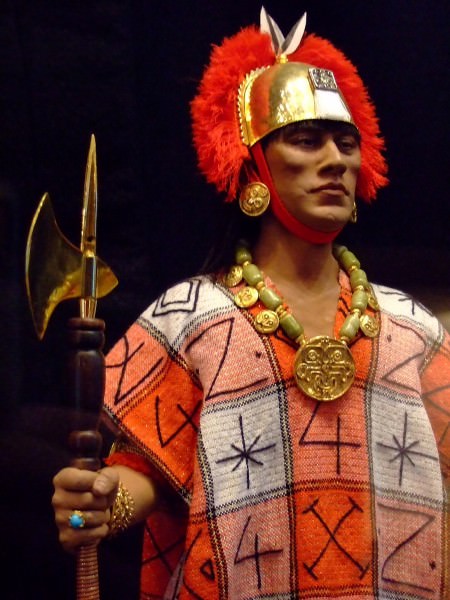
Inca Ruler Atahualpa
Works using precious metals such as discs, jewellery, figures, and everyday objects were made exclusively for Inca nobles, and even some textiles were restricted for their use alone. Goods made using the super-soft vicuña wool were similarly restricted, and only the Inca ruler could own vicuña herds. Ceramics were for wider use, and the most common shape was the urpu, a bulbous vessel with a long neck and two small handles low on the pot which was used for storing maize. It is notable that the pottery decoration, textiles, and architectural sculpture of the Incas did not usually include representations of themselves, their rituals, or such common Andean images as monsters and half-human, half-animal figures.
The Inca produced textiles, ceramics, and metal sculpture technically superior to any previous Andean culture, and this despite stiff competition from such masters of metal work as the expert craftsmen of the Moche civilization. Just as the Inca imposed a political dominance over their conquered subjects, so, too, with art they imposed standard Inca forms and designs, but they did allow local traditions to maintain their preferred colours and proportions. Gifted artists such as those from Chan Chan or the Titicaca area and women particularly skilled at weaving were brought to Cuzco so that they could produce beautiful things for the Inca rulers.
COLLAPSE
The Inca Empire was founded on, and maintained by, force, and the ruling Incas were very often unpopular with their subjects (especially in the northern territories), a situation that the Spanish conquistadores, led by Francisco Pizarro, would take full advantage of in the middle decades of the 16th century CE. The Inca Empire, in fact, had still not reached a stage of consolidated maturity when it faced its greatest challenge. Rebellions were rife, and the Incas were engaged in a war in Ecuador where a second Inca capital had been established at Quito. Even more serious, the Incas were hit by an epidemic of European diseases, such as smallpox, which had spread from central America even faster than the European invaders themselves, and the wave killed a staggering 65-90% of the population. Such a disease killed Wayna Qhapaq in 1528 CE and two of his sons, Waskar and Atahualpa, battled in a damaging civil war for control of the empire just when the European treasure-hunters arrived. It was this combination of factors - a perfect storm of rebellion, disease, and invasion - which brought the downfall of the mighty Inca Empire, the largest and richest ever seen in the Americas.
The Inca language Quechua lives on today and is still spoken by some eight million people. There are also a good number of buildings, artefacts, and written accounts which have survived the ravages of conquerors, looters, and time. These remains are proportionally few to the vast riches which have been lost, but they remain indisputable witnesses to the wealth, ingenuity, and high cultural achievements of this great, but short-lived civilization.
Maya Religion: The Light That Came From Beside The Sea › Antique Origins
Ancient Civilizations
The Mayan religious text, the Popol Vuh (known by many names, among them, The Light That Came From Beside The Sea) is the Quiche Maya story of creation translated into Spanish in the early 18th century CE by the missionary Francisco Ximenez from much older tales. As most of the books of the Maya were burned by the Bishop of the Yucatan, Diego de Landa, in July of 1562 CE, this text is all the more important in understanding Mayan culture and religious beliefs even though information is available elsewhere through glyphs, stele, assorted art work, and the three famous Mayan books (known as the Dresden, Paris, and Madrid Codices after the cities where they were taken) which survived Landa's auto-de-fe. The Popol Vuh has been called “the Mayan Bible ” and this designation is unfortunate in that it presents the Mayan text in the interpretative light of the better known western scripture. Unlike the stories and poems which make up the anthology of ancient texts known as `The Bible', the Popol Vuh was never considered a revelatory work by the Maya who heard the tales it contains. It was interpreted by the Maya much in the same way as the ancient Greeks received and understood Homer ’s Iliad and Odyssey : as stories to be understood as the way things could have been, could be, not as any direct `Truth' revealed by an omnipotent god to human beings. The Maya referred to the work as an Ilb'al - an instrument of sight - which provided a hearer with clarity.
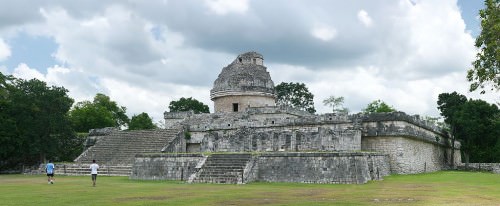
The Caracol, Chichen Itza
The Popol Vuh is a collection of stories which describe the creation of the world, of human beings, and how order was established by the great Hero Twins, Hunahpu and Xbalanque, through their victory over the forces of darkness and death.The characters whose tales are told in the stories are carefully constructed figures who symbolize the planets and the stars and a reader who recognizes this understands that one is encountering in these characters a vision of the world quite different from that presented in the Bible. While the tales told may be mythical in nature, the truths represented could be empirically proven by observing the paths the planets took (most notably Venus ) and the positions of the stars. It was clear to the Maya, from astronomical observations, that all of life was cyclical and this eternal round of existence was made so by the cyclical nature of time.
A WORLD OF SPIRITUAL FORCES
It could be argued that time itself is the supreme god of the Maya pantheon as the intricate calendars of the Maya rose from, and then directed, the religious beliefs. The religion of the ancient Maya infused every aspect of their civilization from their architecture, to their dress and personal appearance, their sports, and, of course, their calendar. The Maya believed that the gods, though living high in the mists of Tamoanchan, were an integral part of their daily lives. The jungles which ringed their cities were inhabited by spirits and by the great god of the woods, Yum Caax, protector of plants and animals. The cities themselves each had a patron god who made the city thrive by accepting the invitation to residence in the central temple.When the rains came, it was because the god Chac was pleased and when the lightning flashed it was the work of the lord Yaluk. Each individual had a `Way', a spirit guide known as a Wayob, who helped him or her throughout life and could appear as an animal, or in dreams, to impart important messages from the spiritual realm. Each year, at the spring and autumn equinox, the great god Kukulcan descended from the sky down the staircase of his temple at Chichen Itza as was (and is still) clearly recognized by the shadow the serpent god moving down the steps to meet the stone heads at the base. The whole of the earth, and human life, then, was imbued with spiritual forces which needed to be recognized, honored, and regularly consulted in order for the community and the individual to prosper.
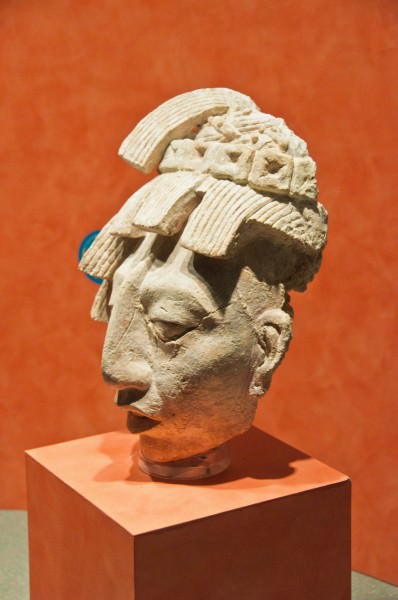
Lord Pacal
THE CALENDAR & ROLE OF THE KING
To the Maya, there was no difference between what a modern-age person would define as ` science ' and religion.Mathematics and Astronomy were a part of religious observance and went to the creation of the Sacred Calendar. The calendar was of such importance that, when the gods made the second attempt to create human beings, they decided to destroy them because the humans lacked the ability to consult the calendar and, so, to honor the gods. The Maya had a secular calendar to track the days and the seasons and a sacred calendar to predict the future and chart the courses of the stars. The scribes and the priests were astronomers and mathematicians and worked to understand the cycles of the planets in order to recognize in those patterns the celestial meaning being imparted by the gods. This meaning, then, would be carried to the ruler of the city who was considered an intermediary between the gods and the people. Blood was the food of the gods and the king and his court were not exempt from this sacrifice. Rituals surrounding royal blood-letting included drawing a string of thorns through the tongue or penis and spiking the ears or tongue with sharp spines. The blood was then let to fall on paper which was burned as an offering to the gods. If the offering was acceptable - so determined by the pattern of the burning paper - the petition of the king and his people was granted and, if not, further sacrifice would need to be made.
HUMAN SACRIFICE
While animals and precious gems were regularly surrendered to the gods in ritual, human sacrifice was central to the religious observations of the Maya (although a modern-day visitor to Mayan sites will hear the tour guides say differently). Excavations in and around the Sacred Cenote at Chichen Itza, as well as at other sites, have revealed bones of what seem to be sacrificial victims and human sacrifice is depicted in stele, in paintings, and in carvings throughout the region the ancient Maya inhabited.Some of these victims were captives taken from other villages or cities but some were citizens of the community who were honored in being chosen as messengers to the gods. Diego de Landa, wrote, “Their festivals were only to secure the goodwill of favor of their gods…They believed them angry whenever they were molested by pestilences, dissensions, or droughts or the like ills, and then they did not undertake to appease the demons by sacrificing animals, nor making offerings only of their food and drink, or their own blood and self-afflictions of vigils, fasts and continence; instead, forgetful of all natural piety and all law of reason they made sacrifices of human beings as easily as they did of birds” (Ancient Maya, 90). Sometimes this sacrifice took the form of being thrown into the Sacred Cenote and, other times, the victim was disemboweled or had the heart torn out on an altar of a temple. As the Maya believed in the cyclical nature of life, nothing ever truly `died', and so the individual sacrificed was considered to have simply `moved on' to live among the gods. Whatever form the sacrifice took did not finally matter because the individual was guaranteed instant transport to the realm of the gods and by-passed the arduous road most other souls needed to travel after death.
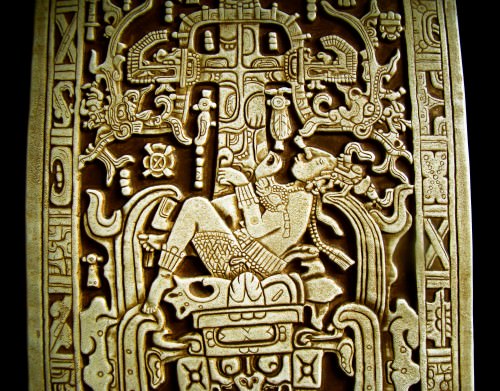
Pakal the Great & Xibalba
THE AFTERLIFE
To the Maya, the afterlife was a journey of the soul toward paradise; but there was no guarantee at all that one would reach one's destination. At death, the soul went down to the underworld, a dark and frightening place called Xibalba (or Metnal) which was populated by terrifying deities with names like Bloody Teeth, Flying Scab, and Bloody Claw. In perpetual darkness, the underworld had rivers of blood and pus and the trees were dead, the landscape barren. The Lords of Xibalba were just as apt to steer a soul in the wrong direction on its quest as the right one. Having arrived in Xibalba, one needed to not only navigate one's way across it but, then, ascend the nine levels to reach the middle world (earth) and then thirteen more levels before arriving at Tamoanchan (paradise). Once one attained the realm of the gods, one would then descend to a lower level, on the earth or just above it, to live in eternal happiness. The only souls considered exempt from this journey were sacrificial victims, women who died in childbirth, those killed in warfare, suicides, and those who died playing the ball game Pok-a-Tok.
THE SACRED BALL GAME: POK-A-TOK
Pok-a-Tok was more than just a popular sport as it symbolized the struggle of the forces of life and death, light and darkness, and, it is thought, was also an act of sacrifice to the gods who enjoyed watching the game as much as the people did. Two teams of seven players each would attempt to score a rubber ball through a sideways hoop attached to a wall (sometimes as high as twenty feet in the air, sometimes lower or higher) without using their hands or feet. Players were only allowed to use their heads, shoulders, hips, elbows, knees and, sometimes, wrists. Scoring a point was so difficult that a single game could continue for days and the play was so rough that participants were frequently killed in the course of it. Prisoners of war were often sent to play in the great ball courts of the cities but not, as many think, as a punishment; they were a sacrifice to the gods. For many years, since engravings and stele concerning the game were first discovered, it was thought that the losing team (or losing captain) was sacrificed but as a clearer understanding of Maya culture has emerged it has become apparent that it was the winning team (or winning captain) who was beheaded at the game's conclusion in that the victim was then sent instantly to paradise. There was no doubt he was received well by the gods because they loved Pok-a-Tok as much as mortals did and would appreciate the gift of an excellent player. Even so, the claim that the winning team was executed is still a subject of some debate. The Mayanists Schele and Matthews contend that, "the most popular [myth surrounding the ballgame] says that the Maya sacrificed the winners so as to give a perfect gift to the gods. There is no evidence for this interpretation in any of the ancient or historical sources" (210). Those who disagree with Schele and Matthews claim that the long-standing belief that the losers were sacrificed, or that prisoners of war were forced to play to the death as a means to dishonor and punish them, is not consistent with the religious and cosmological beliefs of the Maya. The gods would have been uninterested in receiving a losing team or captain as a gift and would have visited the city with wrath instead of benevolence. Further, the concept of the prisoners of war being punished may simply be a conflation of the Maya game in the ball courts and the Romangladiatorial games in the coliseum first suggested by 19th century interpreters of the game. A definitive answer on whether the winners or losers were sent to their deaths is not yet available because extant glyphs are often open to both interpretations.Some modern-day Maya Daykeepers (shamans) have claimed that the winners were killed but whether this is the majority opinion is not known as there has been no systematic study of this particular question with the Daykeepers of the modern Maya.

Goal, Ball Court of Chichen Itza
THE POPOL VUH
The importance of Pok-a-Tok as a religious ritual is illustrated clearly in the Popol Vuh. In this text, the early demi-gods Hun Hunahpu and Vucub Hunahpu (symbolizing planets and fertility) are excellent Pok-a-Tok players. It is their enjoyment of the game, and the noise they make in playing it, which enrages the Lords of Xibalba who invite the brothers to the underworld on the pretext of playing against them in a game. Once the young men arrive in Xibalba, however, they are tricked and murdered.Their bodies are buried under the ball court but Hun Hunahpu's head is placed in the axis of a calabash tree as a warning to others of the Xibalban's strength. This head (which is animated by both brothers) later spits into the palm of the virgin goddess Xquiq and she becomes pregnant with the two boys known as the Hero Twins, Hunahpu an Xbalanque, also both expert Pok-a-Tok players, who defeat the Lords of Xibalba and the forces of chaos and darkness. In playing the game, then, the Maya were re-creating the victory of the twins over death while, simultaneously, honoring the gods in the present with sacrifice. The Mayanist Dennis Tedlock writes, “For Mayans, the presence of a divine dimension in narratives of human affairs is not an imperfection but a necessity and it is balanced by a necessary human dimension in narratives of divine affairs” (Popol Vuh, 59). The divine dimension in the game of Pok-a-Tok was multi-layered and, like everything else in Mayan life, reflected the importance of the gods in one's daily life.
THE CYCLICAL NATURE OF EXISTENCE
The religious beliefs of the Maya, then, were intricately bound up in cycles, whether the cycle of a day, a ritual performed, or the great ball game. All of existence carried on eternally in the great cycle of time and this was illustrated through the calendar, both the secular and the sacred versions. The calendars were envisioned as great cogs with interlocking teeth which clicked precisely and, if understood properly, enabled one to predict future events. Much has been made recently of the Maya allegedly predicting the end of the world on 21 December 2012 but, again, this is a result of interpreting the beliefs of the Maya through a western European understanding. As time was an eternal god, bound up in, outside of, and manifesting itself through the workings of the universe, it could never end. The world brought into being through the operation of time as represented by the gods could never end either as that would contradict the very nature of existence as understood by the Maya. 21 December 2012 is better understood as simply the end of one cycle (known as a Baktun) and the beginning of another as, to the Maya, there is never an end to anything, only ceaseless change through the eternal work of time.
LICENSE:
Article based on information obtained from these sources:with permission from the Website Ancient History Encyclopedia
Content is available under License Creative Commons: Attribution-NonCommercial-ShareAlike 3.0 Unported. CC-BY-NC-SA License